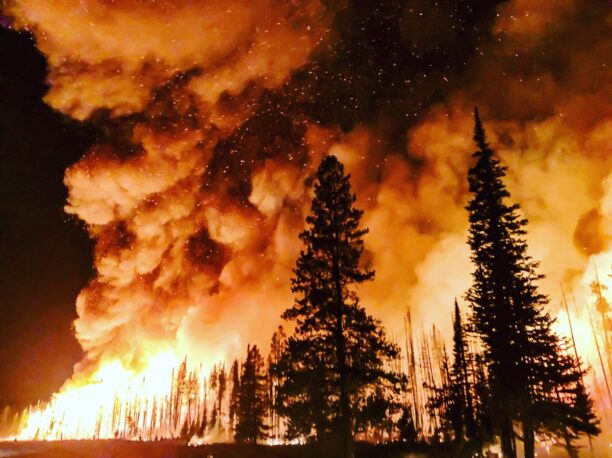Drones One of Five Key Innovations to Protect Forests from Increasing Wildfire and Pest Threats
Climate change is significantly increasing the vulnerability of the world’s forests to stressors such as wildfires and pests, according to a new report by the Food and Agriculture Organization of the United Nations (FAO). Released at the 27th session of the Committee on Forestry (COFO) in Rome, “The State of the World’s Forests 2024” highlights the critical role of innovation in safeguarding forests and achieving sustainability in the forestry sector.

Rising Wildfire Intensity and Pests
The FAO report underscores that the intensity and frequency of wildfires are escalating, including in regions previously unaffected. In 2023, wildfires emitted an estimated 6,687 megatonnes of carbon dioxide globally. Boreal fires alone, driven by prolonged droughts, have reached unprecedented levels, contributing nearly one-quarter of total wildfire emissions in 2021. Additionally, climate change is facilitating the spread of invasive species, with insects, pests, and pathogens threatening forests globally. For instance, the pine wood nematode has devastated native pine forests in parts of Asia, and North American forests are projected to suffer extensive damage by 2027 due to insect infestations and diseases.
Five Key Innovations to Protect Forests
In response to these challenges, the FAO report identifies five types of innovations that can enhance forests’ resilience and sustainability:
- Technological Innovations: The use of artificial intelligence (AI) for analyzing large volumes of optical, radar, and lidar data from drones, satellites, and space stations can significantly improve forest monitoring and management.
- Social Innovations: Engaging women, youth, and Indigenous Peoples in developing local solutions ensures that forest management practices are inclusive and benefit all community members.
- Policy Innovations: Developing and implementing policies that support sustainable forest management and conservation practices are crucial. This includes creating an enabling environment for innovation and fostering partnerships among stakeholders.
- Institutional Innovations: Strengthening institutions to support forest management and conservation through collaboration and capacity building is essential for scaling up innovative solutions.
- Financial Innovations: Enhancing public and private sector financing to increase the value of standing forests and support sustainable forest management practices is vital. This includes creating financial incentives for conservation and sustainable use of forest resources.
Technological Innovations: Forest Management with Drones
Among the five innovations highlighted, technological advancements, particularly the use of drones, stand out as a game-changer in forest management. Drones equipped with AI and advanced sensors can revolutionize the way forests are monitored and managed.
AI and Data Analysis
Drones can collect vast amounts of data through optical, radar, and lidar sensors, capturing high-resolution images and detailed information about forest health, structure, and composition. AI algorithms can then analyze this data to detect changes in forest conditions, identify areas affected by pests or diseases, and monitor wildfire activity in real-time.
Early Detection and Rapid Response
The ability of drones to access remote and difficult-to-reach areas allows for early detection of potential threats such as pest infestations and fire outbreaks. This enables forest managers to respond swiftly, deploying targeted interventions to mitigate damage and prevent the spread of pests or fires. For example, drones can identify and map hotspots during a wildfire, guiding firefighting efforts more effectively.
Precision Forestry
Drones also facilitate precision forestry, where specific areas of a forest are managed with tailored interventions. This can include targeted pesticide application to combat pests or precise water management to reduce fire risk. Precision forestry ensures that resources are used efficiently, minimizing environmental impact and maximizing forest health.
Continuous Monitoring
With drones, continuous monitoring of forest conditions becomes feasible. Regular flights can provide up-to-date information on forest dynamics, allowing for proactive management decisions. This continuous data stream supports long-term planning and helps build resilience against future threats.
Current Wildfire Situation
The report’s release comes at a time when wildfires have become a pressing global concern. Recent years have seen unprecedented wildfire activity, driven by climate change-induced droughts and higher temperatures. The increasing frequency and intensity of wildfires not only devastate forests but also contribute significantly to carbon emissions, exacerbating climate change.
Enabling Actions for Innovation
To scale up these innovations, the report recommends several enabling actions:
- Raising awareness about the importance of forest-sector innovation.
- Boosting skills, capabilities, and knowledge related to innovative forest management practices.
- Encouraging transformational partnerships among stakeholders.
- Ensuring accessible and sufficient financing for forest innovations.
- Providing a supportive policy and regulatory environment to foster innovation.
The FAO’s emphasis on innovation offers a hopeful path forward in protecting the world’s forests from the growing threats of wildfires and pests. By leveraging technological, social, policy, institutional, and financial innovations, and with the support of global partnerships and inclusive approaches, the forestry sector can move towards a more sustainable and resilient future. Drones, in particular, hold immense potential in transforming forest management practices, making them a cornerstone of modern forest conservation efforts.
Miriam McNabb is the Editor-in-Chief of DRONELIFE and CEO of JobForDrones, a professional drone services marketplace, and a fascinated observer of the emerging drone industry and the regulatory environment for drones. Miriam has penned over 3,000 articles focused on the commercial drone space and is an international speaker and recognized figure in the industry. Miriam has a degree from the University of Chicago and over 20 years of experience in high tech sales and marketing for new technologies.
For drone industry consulting or writing, Email Miriam.
TWITTER:@spaldingbarker
Subscribe to DroneLife here.